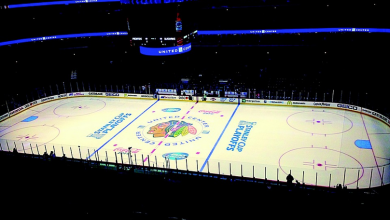Blocking shots is a bad thing?

The Eastern Conference Finals kicked off last night with a 3-0 Rangers win over the Devils at Madison Square Garden. There are many aspects of Game 1 you could focus on – like Henrik Lundqvist looking dominant in his 2nd shutout of these playoffs or Defenseman Dan Girardi bouncing back from a bad 2nd period to score the game-winning goal in the 3rd period. But what’s being focused on the most is the number 26. No, I’m not talking about Devils winger Patrik Elias, I’m talking about the number of shots the Rangers blocked in Game 1. There’s been this growing sentiment among some in the hockey media that the Rangers style of play isn’t good for the NHL and could actually hurt the NHL’s popularity. The Rangers have developed a reputation of being shot-blocking robots, and apparently that’s a bad thing.
There’s no doubt that the work stoppage after the 1993-94 season killed the NHL’s budding upswing in popularity. One of the teams we saw emerge after that was the neutral-zone trapping, left wing-locking, New Jersey Devils. I don’t think any hockey fan will argue that stacking your players behind your own redline, forcing the attacking team to dump and chase or dump and retreat to wait for a better opportunity is sexy hockey. But there was no rule against it, and the Devils sure were successful at it. Three championships and one additional appearance in the Stanley Cup Finals over a nine-year period would be considered a great run by any team in any sport. I don’t think Lou Lamoriello reflects back on any of his championships with the thought of “Yeah we won, but we didn’t win any of those times with an up-tempo, fan appeasing style.” Fast forward about a decade. In that time, the NHL went through another work stoppage and found themselves trying to get the sport back on the radar. Rule changes were made to make the game more exciting and appealing. It took a few seasons, but it worked and hockey started to matter again on a national level again (the first round of the 2012 Playoffs was the most watched first round in the history of the NHL). Just like the Devils style took heat for winning in a boring fashion, it’s now their cross-river rivals at MSG that are catching flak for winning without flare.
One of the criticisms I’ve heard of the high amount of shot blocking is that it used to be an art form and now it’s just players flailing their bodies in front of any shot attempt. Another is that the equipment is better now than it was ten years ago, so it’s less of a decision to lay your body down and take one for the team. If you didn’t know, a hockey puck is 6 ounces of dense, vulcanized rubber. That’s not exactly a Nerf football you’re getting in front of. I don’t care how good the equipment is, a good portion of a hockey player’s body is still exposed. Even when the shot block attempt catches a piece of armor, it can still leave a nice reminder on a player’s body underneath.
Another aspect the critics of massive shot blocking are leaving out is that there is just as much of a risk involved as there is reward of keeping the puck from getting to the net. In the last week of the 2010-2011 regular season, Rangers RW Ryan Callahan sold out to block a slap shot from Bruins Defenseman Zdeno Chara (who holds the All-Star Skills Competition record for hardest slap shot at 108.8 mph, by the way). The shot hit Callahan high on the boot of his skate, breaking his ankle, and essentially ended any chance of the Rangers making a deep playoff run (it’s tough to go far without one of your best players, the Capitals took care of the Rangers in 5 games). Callahan is the epitome of a blue-collar hockey player and was reacting to his instincts. But Rangers Head Coach John Tortorella demands that every player, from a skill guy like Marian Gaborik, all the way down to a gritty defenseman like Stu Bickel, be willing to get in front of a shot. Minimizing shot opportunities is an effective way to win hockey games, but it can come at a price.
Winning a championship in any sport takes grit and sacrifice. In football, we applaud a wide receiver for going over the middle and taking a bone-jarring hit while making a catch to move the chains. In basketball, if someone takes a charge, he’s lauded for his toughness. In hockey, for as long as the game has been around, blocking a shot was the ultimate symbol of sacrifice. It showed that you were willing to put your team ahead of yourself and pay the price. All of a sudden, this is being viewed as detrimental to the game. While I’m an unabashed Rangers fan that’s thoroughly enjoying a deep playoff run, I’d be writing the same thing if the Buffalo Sabres were enjoying the same success via the same method. Tortorella’s approach has led to success nine times in the playoffs so far, and has the Rangers three wins away from playing for the Stanley Cup.
-For more on the Rangers and the NHL, check out PuckingThoughts.Blogspot.com or follow on Twitter @PuckingThoughts

